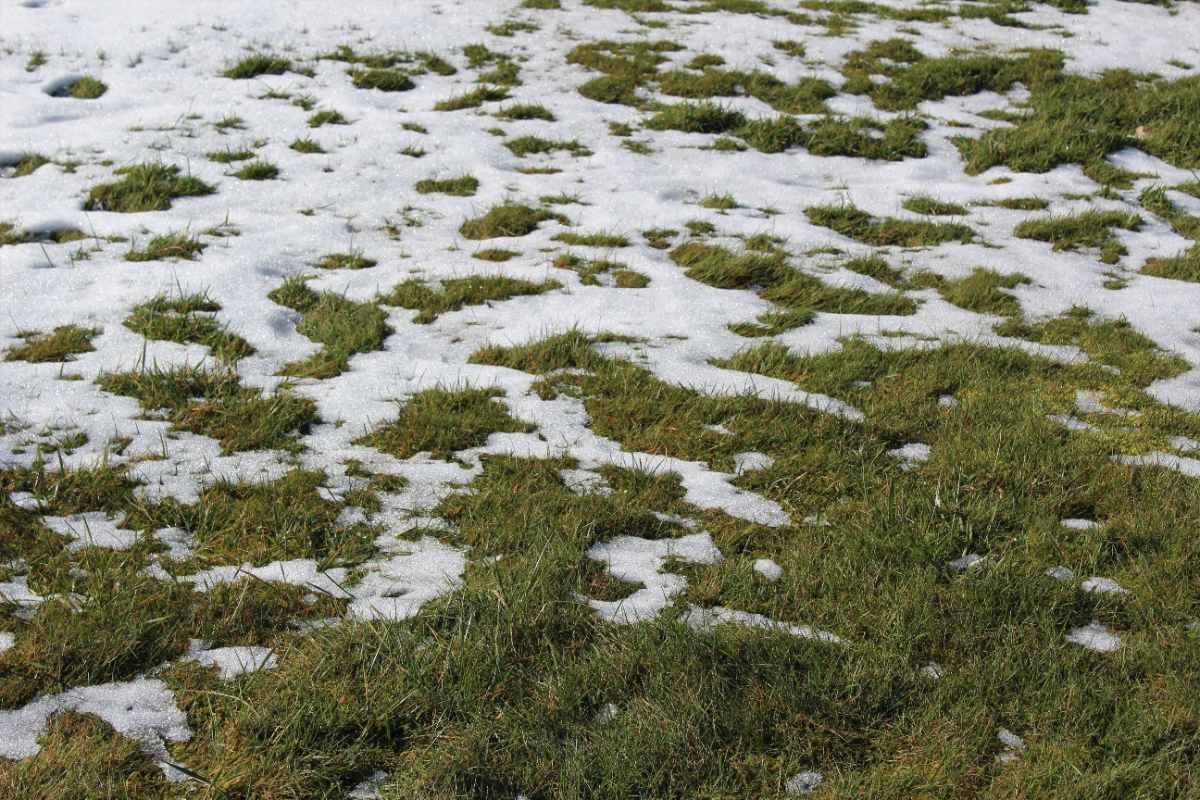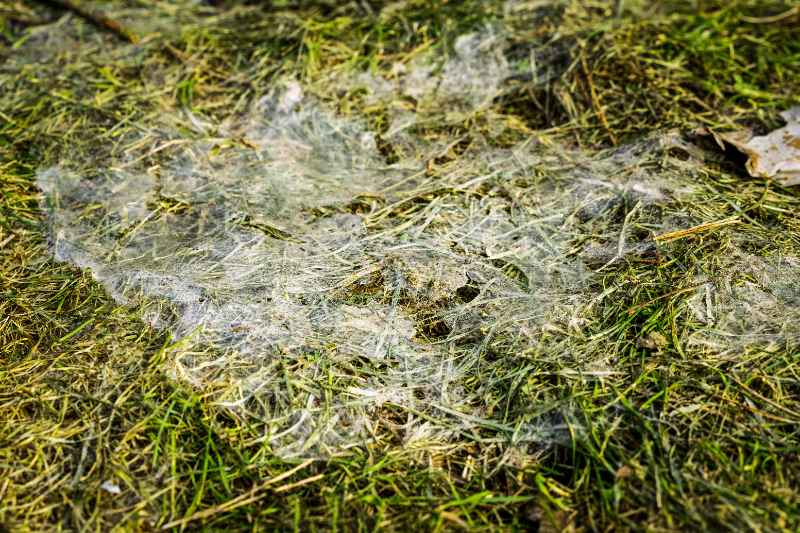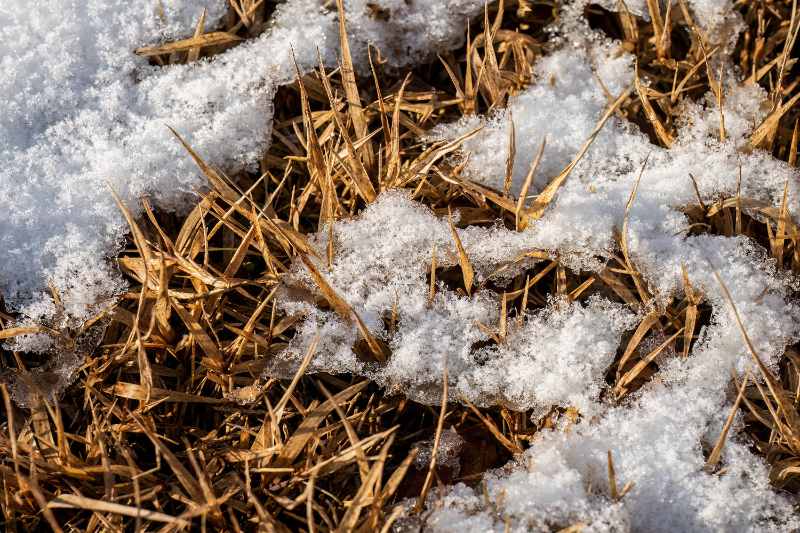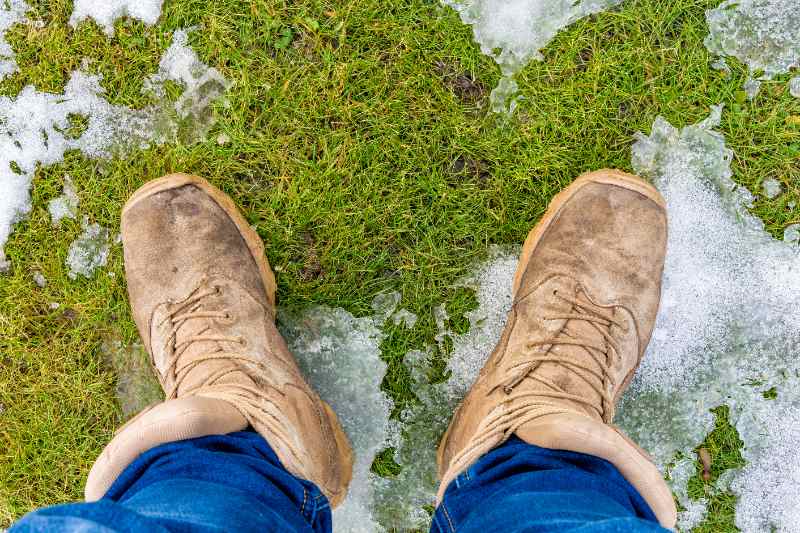
Snow shields grass from killing cold and wind, acts like slow-release irrigation, and keeps seeds dormant until spring. This protection helps most turf survive winter without significant damage.
The downside: Months under snow create perfect conditions for fungal diseases, temperature swings can destroy grass crowns, and ice layers can suffocate turf. A turfgrass expert breaks down how snow and ice affect your lawn — and why removing it is not always the best idea.
The best defense? Proper lawn winterization, whether you tackle it yourself or hire a lawn care professional.
Snow Insulates Grass
Is snow good for grass? Yes, and its superpower is insulation.
One of snow’s main advantages is its ability to trap heat and protect what’s underneath from the extreme cold — similar to how an igloo works, says Stephen Campbell, a turfgrass specialist with Penn State Extension in Butler County.
“This can help protect (the grass) from winterkill that we often see in northern climates,” Campbell adds.
Even a modest 2-4 inch blanket can raise soil temperatures by 30-35 degrees F compared with bare ground exposed to freezing cold, says Michigan State University. Tucked under that white cover, grass roots and crowns rest dormant, safe from dry winds that would otherwise freeze-dry the turf.
Snow Stores Moisture

Think of a snowpack as a slow-drip irrigation system. Throughout winter, it parcels out moisture while shielding the soil from drying winds and sun.
Come spring, that stored water soaks in gradually, hydrating the grass as it greens up. Roughly 10 inches of snow equals 0.4 to 1 inch of water, according to the National Snow and Ice Data Center, although this varies with snow density.
Here’s how snow moisture affects your lawn care schedule:
- Snow belt dwellers, aerate your lawn in the fall to prevent runoff and water pooling during sudden snowmelts.
- In regions with lighter, inconsistent snowpack, you may need to water the lawn in winter to keep roots from drying out.
Snow Delays Germination
Dormant seeding in late fall? Snow is your ally. It keeps the seeds from germinating during winter’s inevitable warm spells.
Those teasing 50-degree stretches in January or February can trick bare soil into spring mode. Without snow cover, seeds germinate right into the next freeze. But under the snow, they wait as temperatures hover just around freezing: cold enough to maintain dormancy, yet mild enough to keep seeds viable. When spring finally arrives, they’re ready.
See Related: How to Dormant Seed Your Lawn
Snow Adds Nitrogen
As snowflakes fall, they trap atmospheric nitrogen. When they melt, that nitrogen enters the soil — a modest bonus for spring growth.
Rain and snow together deposit 3-6 pounds of nitrogen per acre annually in the Midwest, according to the National Atmospheric Deposition Program. Sounds like a lot until you realize lawns typically need 45 to 175 pounds per acre each year. Combined, rain and snow contribute less than 13% of the total.
After a heavy winter snow, should you adjust your fertilizer? No. The amounts are too small to matter. Instead, watch how your lawn greens up. Strong and thick? Skip the early feeding. Thin and pale? Fertilize as planned.
See Related: 6 Different Nitrogen Sources for the Lawn
Snow Can Cause Snow Mold

That sheltered zone under snow, so good for dormant grass, is equally hospitable for fungi. The trade-off, Campbell warns, is snow mold.
Months of snow cover create a damp incubator hovering just above freezing, where snow mold fungi thrive. When snow retreats in March or April, you’ll see circles of matted grass in shades of gray-brown or pink.
Looks dire, but usually isn’t. The fungi die off naturally as temperatures rise. To speed recovery, clear lingering snow piles, rake out matted patches, and apply some nitrogen.
Where snow persists for months, rely on snow mold prevention: ease up on late nitrogen and don’t plow snow onto the lawn. If snow mold is a regular problem, apply a fungicide in November, before the first snowfall. These practices limit damage, says Campbell.
See Related: How to Get Rid of Snow Mold
Melting Snow Can Soak Grass Crowns
Snow cover means spring moisture — usually a good thing. When temperatures fluctuate wildly, though, that moisture can be fatal.
Crown hydration works like this: In late winter, warm spells (50 F to 60 F in February or March) break grass dormancy early. Melting snow saturates the soil, and grass crowns absorb the water. Then overnight temperatures crash. Water freezes into ice crystals that rupture cells and destroy the crown. Without it, the plant can’t produce new growth, and it dies.
Damage appears weeks later as random brown patches. Grasses that wake up early (annual bluegrass, perennial ryegrass) take the worst hit.
To limit the damage: Don’t pile snow on your lawn (yes, that includes snowmen), winterize properly in the fall, and avoid high-nitrogen fertilizers after mid-October.
Ice Can Dry Out Your Lawn

Winter desiccation causes more turf loss than any other factor in cold, dry regions like the northern and central Great Plains. The mechanism? Grass loses water faster than it can replace it. Once the water content drops below 50%, the plant dies.
Ice compounds the problem by locking soil moisture in a frozen state that grass roots can’t access. Add sunny days or dry winds that pull water from blades and stems, and you get a deadly imbalance — water going out, none coming in.
South- and west-facing slopes are most vulnerable, especially those on elevated, wind-exposed sites with sandy soil.
You can help by buffering the dry winds, and Campbell says two strategies can help: topdressing with sand in the fall and installing windbreaks (such as trees or wooden fences).
See Related: What is Winter Desiccation in Your Lawn?
Ice Can Suffocate the Grass
Freeze-thaw cycles build solid ice layers, especially in low spots where water pools and soil is compacted. Extended ice cover cuts off oxygen, and dormant grass, which still respires (breathes), can suffocate.
Survival is difficult to predict and depends on factors such as ice thickness, duration, grass species, and turf health, Campbell says.
Tempted to break up the ice? Don’t. Campbell advises leaving it alone. Breaking the ice exposes vulnerable grass to wind and frigid temperatures, which are more damaging than any oxygen benefits.
Most turf tolerates 90+ days under ice, so healthy lawns, properly cared for in the fall, emerge undamaged come spring.
Walking on Snow Compacts the Soil

Snow and ice sitting on your lawn don’t cause severe compaction on their own. The weight is evenly distributed — think of lying flat on a bed versus standing on it. Problems begin with additional pressure: piled snow (more weight on a smaller surface) or foot traffic.
Under the snow, the soil is moist and compresses easily. Walk on it and you concentrate your full weight onto shoe-sized patches. For a 180-pound person, that’s about 35 times more pressure than a one-foot-thick layer of heavy, wet, compressed snow creates. Enough to crush some of the air pockets the roots need.
To avoid compaction, keep off the lawn when snow-covered or during snowmelt. Besides compacting the soil, you also risk damaging frozen grass. Instead, wait until the lawn has thawed and dried.
See Related: What Causes Compacted Soil?
Should You Remove Snow?
Probably not, says Campbell. “If you take a look at your local golf course that has bentgrass, poa annua, and other species, (which are) cut at a much lower height than your lawn, they aren’t removing the snow.”
Each situation is unique, and homeowners should carefully weigh the benefits and trade-offs.
Removing lingering piles of snow in the spring helps reduce snow mold. However, when done mid-winter, you lose insulation against temperature swings and risk ice damage, as well as compacting saturated soil or scraping turf with your shovel.
FAQ
Dormant grass resists winter damage better. Mild winters trick grass into breaking dormancy early, leaving it vulnerable to cold snaps and dry winds. Severe winters keep grass dormant until spring.
Not really. Remove the snow from the pavement near your lawn with a shovel or use safer de-icers, such as calcium magnesium acetate.
Call in the Pros
If winter left your lawn looking worse for wear, don’t tackle the damage alone. LawnStarter connects you with trusted local lawn care pros who can assess the damage and get your lawn back in shape — fast. Get your free quote and let the experts handle the heavy lifting.
Read More: How to Care For Your Lawn in Winter
Sources:
- “Nitrogen from the Atmosphere.” By environmental specialists Tom Butler, Cornell University and the Cary Institute of Ecosystem Studies, Greg Beachley, U.S. EPA Clean Air Markets Division, Cari Furiness, North Carolina State University, and Pamela Padgett, U.S. Forest Service. National Atmospheric Deposition Program.
- “Nutritional Value for the Landscape.” University of Nebraska-Lincoln.
- “Snow.” National Snow and Ice Data Center.
- “Snow a Welcome Sight for Farmers.”By James DeDecker, director at MSU Upper Peninsula Research and Extension Center. Michigan State University.
- Stephen Campbell, turfgrass specialist and Extension educator with Penn State Extension in Butler County. Personal interview.
- “Think Twice Before Removing Ice.” By Bob Vavrek, regional director for the Central Region. United States Golf Association.
Main Image: Melting snow on grass in a lawn. Image Credit: octobersun / Adobe Stock